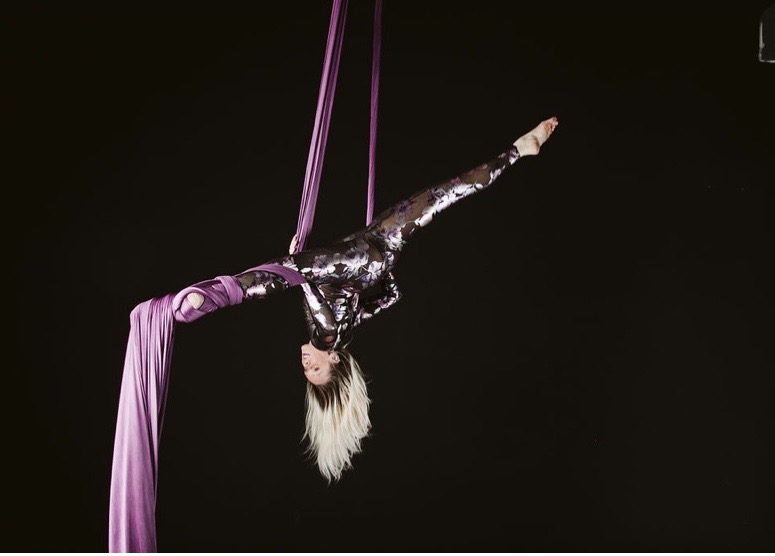A Parent's Guide to Supporting Young Aerialists - No you don't need to buy them an aerial rig after their first class.
- Sara B Schwab

- Jun 11
- 5 min read
The world of aerial arts is captivating, offering young performers the opportunity to develop strength, coordination, creativity, and confidence in ways that few other activities can. Aerial disciplines such as trapeze, silks, hoop, and sling or hammock allow children to express themselves through movement and explore the limits of their physical abilities. If your child has expressed interest in becoming an aerialist or has started training in the discipline, it's natural to want to support their passion while ensuring their safety and well-being. This guide offers advice for parents navigating the world of young aerialists, from understanding the sport to fostering a positive and supportive environment.
Understanding Aerial Arts for Young Performers
In order to fully support your young aerialist, it's important to have a solid understanding of what aerial arts involves and how aerial differs from other types of performance or physical activities. Aerial arts requires a combination of strength, flexibility, and technique, and takes years of dedicated training to understand and master. Aerial should always be taught in a progressive format, meaning that beginners start with foundational skills before advancing to more complex and risky tricks.
Aerial is an inherently risky activity with risks similar to more familiar activities like gymnastics, equestrian sports, and cheer. Like all of these activities, aerial is quite safe when taught by trained instructors in a controlled environment. Classes for young students usually begin with apparatuses that are low to the ground and equipped with mats for safety. As they grow and gain strength, they may transition to more advanced aerial apparatuses that require greater technical skill, understanding, and body control.
The Benefits of Aerial Arts for Children
Aerial arts can provide numerous benefits for young athletes, both physically and mentally.
Physical Fitness: Aerial arts build core strength, improve flexibility, and enhance overall body coordination. It’s a full-body workout that engages all muscle groups, helping children develop strength, endurance, and balance. Regular practice can improve posture and overall health.
Confidence and Self-Esteem: As young aerialists learn new skills and progress in their training, they often experience a significant boost in self-confidence. The sense of accomplishment that comes from mastering a difficult trick or performance can translate to a more positive self-image.
Creativity and Expression: Aerial arts provide an outlet for self-expression and creativity. Students have the opportunity to explore movement in new and exciting ways, often incorporating dance and performance aspects into their routines. This fosters emotional intelligence and a greater sense of personal creativity.
Focus and Discipline: The technical nature of aerial arts requires focus and attention to detail. Children must practice regularly, follow instructions, and push through challenges to improve their skills. This encourages discipline, perseverance, and the ability to overcome obstacles.
How Parents Can Support Their Young Aerialist
While the technical training and guidance from qualified instructors are essential for young aerialists, parents play a crucial role in supporting their child’s passion. Here are several ways you can help:
1. Encourage Consistent Practice and Attendance
Like any sport or performance discipline, consistent practice is key to improving in aerial arts. Children are never too young to learn the importance of being part of a team, keeping up with their commitments, and learning to prioritize their activities. Encourage your child to attend classes regularly and stay engaged with their training. However, it’s important to recognize when they need a break or some downtime to prevent burnout or injury. Balance is essential.
2. Provide Emotional Support
As your child faces the challenges of aerial arts, they may encounter moments of frustration or self-doubt. Be there to offer words of encouragement when they struggle with a new trick or technique. Remind them that progress takes time and that perseverance is key. Celebrate the small victories along the way, not just the big ones.
3. Foster a Growth Mindset
Support your child’s development by helping them cultivate a growth mindset—an understanding that skills are built through effort and practice. When they make mistakes or face setbacks, emphasize the learning process rather than focusing on perfection. Show them that challenges are opportunities for growth. Private lessons are always there to support individual goals, but learning to trust the process is also a valuable lesson.
4. Stay Involved with Their Training
Attend your child’s performances, showcases, and recitals, if possible. It’s encouraging for them to know that you’re invested in their aerial journey. If your child is in a competitive environment, make sure to celebrate their efforts, regardless of the outcome. Not every performance or competition will result in a win, but the experience is invaluable.
5. Ensure Safety and Health
Safety should always be the priority in aerial arts. Make sure that your child’s instructors are well-trained and follow proper safety protocols, such as using appropriate equipment, checking rigging, and providing progressive instruction. As an additional safeguard, ensure that your child wears the right clothing and gear, such as fitted workout attire and no jewelry, to avoid injuries.
In addition to physical safety, encourage good habits around warm-ups and stretching, before practice. Aerialists put significant strain on their bodies, and taking care of muscles and joints will help prevent injury and increase longevity in the sport.
6. Help With Time Management
Balancing school, aerial training, and other activities can be tricky. Work with your child to develop a schedule that accommodates their aerial classes while ensuring they also have time for homework, rest, and family activities. Teach them how to manage their time effectively so that they don’t feel overwhelmed.
7. Maintain Open Communication
Your child may not always express their feelings about their aerial training, so it’s important to keep the lines of communication open. Ask how they feel about their classes, if they have any concerns, and if there’s anything they need from you. This dialogue helps ensure that their experience remains positive and fulfilling.
The Importance of Support Outside the Studio
While the technical side of aerial arts is important, equally vital is fostering a well-rounded life outside of the studio. Encourage your child to participate in activities outside of aerial to help them develop social skills, broaden their interests, and ensure they have a healthy balance between their athletic and artistic pursuits and their personal life. This balance can also help prevent burnout.
Conclusion
Supporting a young aerialist is a unique and rewarding experience for parents. By offering encouragement, providing a safe environment for training, and helping your child navigate the ups and downs of their aerial journey, you can help them thrive both as a performer and as an individual. Aerial arts offer incredible opportunities for growth, creativity, and self-expression—just remember to keep the experience positive, safe, and enjoyable. Your involvement as a parent can make all the difference in helping your child soar to new heights.




Comments